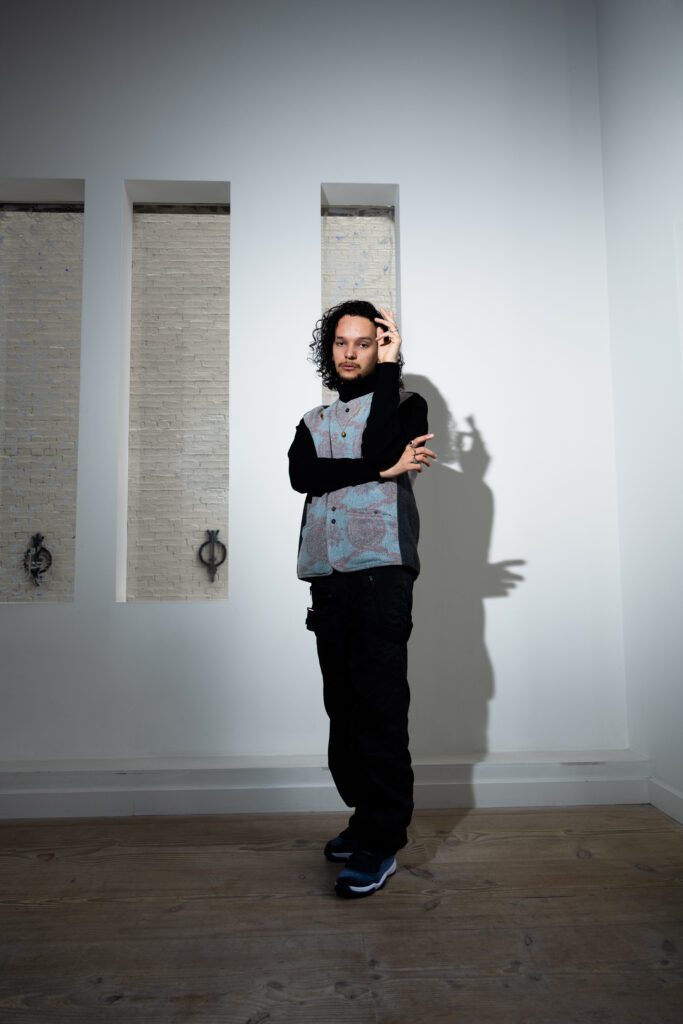Who are you and what do you love most about what you do?
I’m a multidisciplinary artist from the Caribbean island of Aruba. I am in a constant 3/4 dance between Nostalgia and Melancholia. It’s about having conversations with my inner child and memories, while honoring and venerating the obstacles that shaped me as a person. I have an obsession for freedom through a non-fearful manner, using my body as an altar to feel my pulsation, breathing, and all the emotions that transcend through my voice and body. I am using my mothers’ rituals to activate the road to healing and decolonize all traumas from a non-western perspective. That’s what I love to do, being in an endless dance with myself.
Which role does sustainability play within your work/practice?
My work consists of using all types of materials, and the rest of materials. I try to get materials that are already there for us to use instead of buying new materials. Therefore, I need to recycle as much as possible and experiment with unconventional materials to find new ways of defining what a Aruban Identity is. I want to tackle taboos that live on the island and bring new possibilities for the community to reclaim their authentic identity. That means I have to feel and work with all materials to deconstruct them and then rebuild them into new objects, fashion, and music for my practice.
The new exhibition at Fashion for Good is called Knowing Cotton Otherwise. Can you tell us more about your contribution to this exhibition and what your process was like?
My contribution to this exhibition is showing a different side of what cotton is to me. Cotton is not only a fabric, but goes back to the history of slavery. For me, it was very important to decolonize the space in an honoring way to my own culture. Europe often forgets to connect and learn from other perspectives and cultures.
What do you hope for people to take away after seeing your work in the museum?
I hope that my work is a portal to transport them into a different reality where they can encounter courage for freedom. I wish for them to find their inner self again and try to live life without any fear. I want my work to bring compassion and more people together. I want my work to educate and inspire others. If I can help one person to be in touch with their emotions, I have done my job correctly.
The exhibition Knowing Cotton Otherwise is based on collectivity and community. Why is a community-driven mindset that strives for collectivity important to you?
If you’re not sharing and helping other communities, you become a problem to society. Community work is essential to build an ecosystem of opportunities for various voices and to bring new ideas to the table. New ideas propel new solutions.
You express yourself through various mediums, from music, to fashion and performance art, as well as installations. How did you get involved in exploring all of those mediums? And which medium did you use as the first step in your creative process?
From a young age, I already had the intuition to create. I am someone who can’t stay in one place and can’t sit quietly. I was always a curious boy. As a kid, my body was so charged to discover new things and learn new techniques. I saw my ideas getting bigger, and I knew that fashion was not satisfying my urges anymore. That means, I was constantly trying to find new ways to elevate my practice. I was trying to put different disciplines together even though they didn’t fit together as I was trying to find that missing puzzle. I need to listen to my body. A lot of the time, my body wants to perform, sing, dance and deconstruct objects. So I lock myself in my room and marinate in all my emotions. Doing all the things my body wants is the way I got more involved with more mediums and bringing everything together, creating my in-between utopian world.






